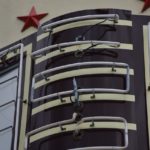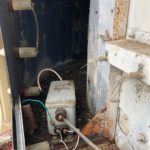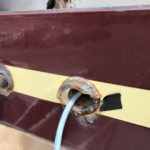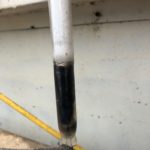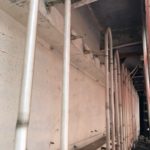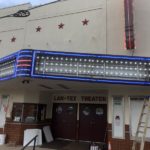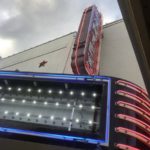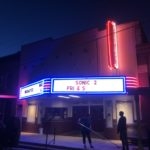Neon Theater & Marquee Restorations
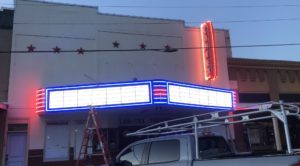
Texas has many beautiful theaters that were built from the 1930’s to the 1960’s. These venues are often historic landmarks that helped define a town, and drew the community together. Many of these are in poor condition. Years of deferred maintenance, and service by unqualified persons have rendered them inoperable.
The good news is that many of these can be both restored and improved. The workmanship on most of them was originally top notch, using time-proven glass neon and porcelain faces that remain unmatched even today in durability. We get many calls for these projects, and this entry is both to showcase our work as well as help the end user determine if a restoration is viable. Some additional pictures below show the typical inside of a theater marquee, as well as some of the steps in the restoration process.
The first step is an inspection to determine a course of action. We look inside, and catalog the issues we find and take many pictures and measurements. The integrity of the electrical and ground system are first. We never assume a sign is grounded, or that the pieces are properly bonded together. In many cases we install additional bonding jumps to ensure the display is safe, and that ground-fault circuitry will function properly.
All glass housings are inspected and cleaned. These are long-life items, that generally do not age. If any have racks or other defects, they are replaced. Interior high-voltage wiring is replaced with new, long-life silicone cable listed for the purpose. Porcelain cable supports are added, if needed. Older neon transformers (pre 1996) are replaced with code-compliant modern units with secondary ground-fault protection.
Often the colors have been replaced by different brands and gases over the years. If possible, we try to reference historic photos or eye-witness accounts to restore the original colors.
Should you change a theater marquee to LED faux-neon?
Our honest opinion: No! These displays were designed for real neon. The LED neon-like products have a very different look, and are generally less durable than glass neon. How is this possible? It is true that glass neon is susceptible to breakage from hail, etc. However, the comparison ends there. Glass tube neon fares much better in the Texas heat, and in an electrical sense it is quite robust. It’s easier to replace neon with an identical unit, as the colors have been standardized over half a century. Lastly, the energy consumption is almost identical. 15mm neon running at 30ma (which is the majority used on theaters), consumes around 3 watts/ft on a properly loaded system. LED neon-flex? About 3 watts/ft – and the light only comes out one direction vs the 360 degree halo provided by glass neon. LED strips run off DC, which poses more problems when moisture is present than AC, which glass neon is powered from. The major reason these signs get retrofited with flex-LED is because the contractor lacks the crucial skills to property service the neon.
The illumination behind the changeable letters is a very different story. This illumination is behind a plastic face, and projects in only one direction It’s protected from the elements. For this, LED’s are the best solution. Retrofitting these older signs with LED’s is a more complicated job than it would first appear, and we have run into so many examples of bad workmanship that others attempted to do on a sign. A proper retrofit involves the complete replacement of the back-lit lighting system. It’s surprising how many times we find a sign that still has the old power supplies installed, and still powered up with nothing hooked up to them! The LED’s need to be of high quality, properly installed with mechanical fasteners (not self stick tape!), and attention given to the thermal management of the LED modules. While LED’s do not get hot, they degrade quickly when subjected to intense Texas Summer temperatures. They also need to be chosen carefully based on the color temperature desired, and the distance to the sign face or background.
Lastly, should you paint a historic neon marquee or sign? Absolutely not, especially if the sign faces are porcelain. This type of graphic lettering is permanent, and will last for all practical purposes “forever”. Porcelain is actually a finely powdered, colored glass that is melted and fused onto the metal. It’s an expensive process, still used today for signs needing the ultimate in longevity.
It takes planning, and a good bit of work, but we can breath new life into an older theater sign or marquee. We are happy to discuss, free of charge the feasibility of your theater neon project.
